Abstract
Intelligent Transportation Systems (ITS) first appeared in 1868 with traffic lights. With developing technology, the need to bring a smart approach to transportation applications within the scope of speed and environmental protection has emerged. Protecting ITS infrastructure against cyber attacks has become a matter of reputation for states. It is essential to provide the necessary technological infrastructure for the integrated operation of the systems used in ITS, especially geographical location, communication, and mapping. These technological developments bring cyber attacks, risks, and many dangers that should be avoided, especially on the systems used. This study examines ITS architecture, applications, communication technologies, and new trend technologies in detail. This study includes contributing to studies in the field of ITS and preventing attacks and incidents that may occur in terms of cyber security. The most important cyber attacks that may occur in ITS applications are included. In addition, the minimum security requirements that can be taken in ITS applications and infrastructures against these attacks are included.
1. Introduction
Intelligent Transportation Systems (ITS) were first conceived as a system in which red and green lights were lit in London in 1868. In this system, red meant “stop”, green meant “movement”, and traffic lights were gas powered. It was decided that these systems could be built while the police stood next to them to light the whole day. Traffic increased drastically with the invention of cars, as cities became more crowded with the development of industrialization in the early 1900s. Also, in 1912, Lester Wire, an American traffic cop, was the first to develop an electric traffic light []. The world’s first electric traffic lights entered service on 5 August 1914, and the installed lamp had a height of 5 m. The lights were colored as before, and there was also an audible warning shortly before the lights changed. Electric traffic lights of that time are considered to be the first ITS applications and worldwide projects were developed one after another in the Eastern Inter-Country competitive environment to accelerate the development of ITS: Global Positioning System (GPS)-based route selection, electronic cruise control, in-vehicle systems, as well as traffic lights such as rapid transit systems, dynamic control systems.
The accepted form of ITS in international standards also includes road applications. ITS is a system engineering application that uses information and communication technologies to operate and manage the road network’s infrastructure and superstructure, which includes intercity and urban roads. To eliminate or reduce the disadvantages that come with the benefits of advanced transportation systems, the concept of ITS has emerged to enable transportation systems to operate more efficiently, environmentally friendly, safely, and economically. ITS has become the focus of various policies and action plans worldwide. When the foundations of ITS studies were examined, Comprehensive Automobile Traffic Control Systems (CACS) in Japan and Electronic Route Guidance Systems (ERGS) appeared in the USA and Germany in the late 1960s. After these years, ITS applications started to become widespread in the mid-1980s. They were first implemented in the 1990s with applications such as electronic toll collection systems, smart intersection control systems, passenger and driver information systems, and traffic control centers. With these practices, cooperation between the public and private sectors has started, and joint projects have been developed. After studies on an international scale began to gain importance, the first ITS congress was held in Paris in 1994 and has continued to take place regularly in a different country every year since then. As a result of these activities and academic studies in ITS, countries have started to establish their own ITS organizations in line with the knowledge gained, emerging technological developments, and needs. In addition to organizations established nationally, regional organizations such as European Road Transport Telematics Implementation Coordination (ERTICO), ITS America, and ITS Asia Pacific [].
The security of ITS applications is essential in terms of identifying threat factors. Potential security threats include criminal gangs, intelligence from nations, hackers, cyber terrorists, and natural disasters. For example, a nation’s ITS infrastructure is in a perilous situation during a war by hostile nations to bring systems down []. It is in demand from attackers that ITS applications have a significant impact as a result of attacks. Information can be obtained through physical, wired, or wireless network attacks. When a ransomware attack occurs, the attackers do not give the decryption keys to the other party until the ransom is paid. If a vehicle is accessed after the attack, it cannot function until the ransom is paid. Attacks on these vehicles can generate traffic if a fake vehicle-to-vehicle (V2V) message is transmitted, and this attack can initiate V2V information poisoning. Also, security vulnerabilities are possible in ITS to endanger GPS receivers and GPS signal spoofing in vehicles and payment systems []. Studies conducted in recent years show that with the increase in awareness about ITS and the tendency of ITS stakeholders to act together, their work has accelerated.
For this reason, developing countries need to make ITS planning safe, economical, environmentally friendly, solution oriented, and user-friendly by following ITS stakeholders’ views and the relevant ministries’ goals. With technology development in ITS, security attacks that pose significant risks have begun to emerge. The fact that there is a danger of death in these areas where security cannot be significantly ensured increases the severity of these attacks [].
Many research studies have been carried out in this area in the literature. However, in the context of ITS, cyber security and the necessary precautions still need to be adequately addressed. Rafat and Azadi proposed a new automatic lane change algorithm for designing flexible lane change trajectories in a complex, dynamic environment. This method can design paths during a lane change maneuver with integrated acceleration and turning angle control []. Lamssaggad et al. studied the current security environment at ITS, and in-depth analysis was conducted to identify missing elements in the design of existing security solutions. In addition, emerging defense mechanisms that provide solutions to the shortcomings of existing countermeasures and new/emerging cyber attacks are introduced []. According to Lu et al., Vehicular Ad Hoc Network (VANET) protects privacy and trust management [].
Potential effects on public safety and system functionality of the critical nature of transport infrastructure and security violations are very important in ITS security. Protecting sensitive data such as traffic flow information, vehicle location data, personal passenger information, access controls, and secure data transmission protocols must maintain data integrity and privacy. It is very important to secure communication networks that connect various components. To prevent unauthorized tampering or manipulation, it is vital to ensure the safety and integrity of the systems. Maintaining physical infrastructure such as traffic signal control cabinets, surveillance cameras, and roadside sensors is essential. Creating resistance and surplus on systems is critical to protect operations in the face of cyber attacks or system failures. To prevent unauthorized access, the identity of users and devices accessing their systems must be verified. To minimize the effect of safety events, it is very important to determine solid event response and recovery procedures. It plays an important role in protecting systems against cyber attacks, such as ISO 27001 [], NIST Cyber Security Framework [], and General Data Protection Regulation (GDPR) [].
This study explains the general definition of ITS and its architecture, applications, and technologies. In particular, ITS applications that can be used in line with the information provided by international standards publishing institutions such as ETSI [], NEMA [], and ISO are included. It is emphasized that ITS applications can be used with rapidly developing technology applications such as artificial intelligence, machine learning, the Internet of Things (IoT), blockchain, 5G, 6G, quantum technologies, cloud computing, new generation security algorithms, and big data. Communication technologies used in ITS applications are explained. In addition, security issues and potential cyber attacks against ITS are discussed. Finally, the minimum requirements for security in ITS are discussed.
2. Intelligent Transportation Systems
ITS has been developed to shorten travel times, increase traffic safety, use existing road capacities efficiently, increase mobility, use energy efficiently, and reduce environmental damage with versatile data exchange between users, vehicles, infrastructure, and the environment. In addition, information communication-based systems include central measurement, analysis, and control mechanisms. ITS is aimed at minimizing human-induced errors. In addition, traffic-related time loss, fatal and injury accidents, financial losses, air pollution, and many similar negative situations can be prevented. The general view of ITS and its urban applications are shown in Figure 1.
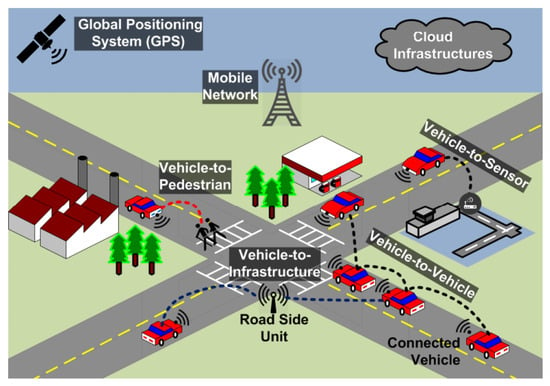
Figure 1.
Intelligent Transportation System [].
ITS is an information and communication technology-supported and integrated transportation system. ITS encompasses sustainable, safe, and interconnected transport systems, including trams, buses, subways, cars, sea and air transport, bicycles, and pedestrians. Intelligent transportation aims to provide a different and smarter perspective on the transportation system, which includes traffic management, road safety, and many other aspects. Transport services are safer and more environmentally friendly, focusing on freight and passenger transport. It also invests in the present and the future with the developed ITS. It is possible to produce economically, environmentally, and socially sustainable solutions, especially by providing fast and efficient access to information. In addition, ITS applications have begun to be developed to increase the efficiency and safety of road access systems. It aims to develop computer, electronic, and communication technology applications to provide passenger information, especially for the users of this system []. In the ITS overview, V2V and vehicle-to-infrastructure (V2I) communication in Figure 2.
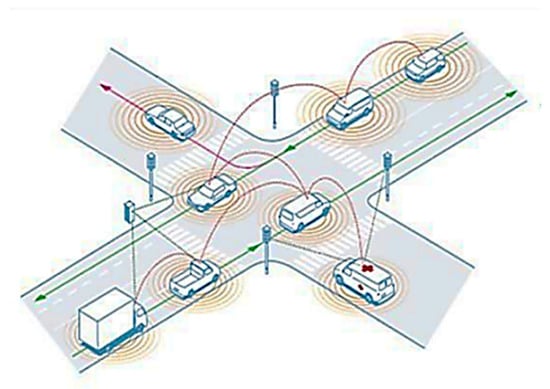
Figure 2.
ITS path example [].
2.1. Intelligent Transportation System Applications
ITS applications consist of vehicles and users’ electronic payment systems, automatic parking systems, travel assistance systems, accident avoidance, traffic lights, and security systems. All of these systems communicate within themselves, and data are sent and received between them. Safer journeys are aimed thanks to security systems and sensors. Electronic payment devices are a basic infrastructure system for ITS users. The systems can be grouped into four main groups from the transportation management perspective. ITS provides significant access to cleaner, safer, and more efficient transport systems. Due to their superiority, ITS systems are applicable in all areas of road, airways, seaway, and railway transportation and have been integrated into all systems and subsystems used []. ITS general applications and subsystems of the applications are shown in Figure 3.
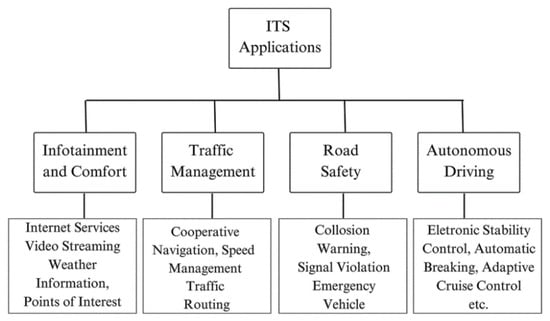
Figure 3.
ITS applications [].
ITS applications encompass a diverse range of technologies and solutions to enhance transportation networks’ efficiency, safety, and sustainability. Here are some key applications of ITS []:
Traffic Management: ITS utilizes real-time data collection, traffic monitoring sensors, and predictive analytics to optimize traffic flow and reduce roadway congestion. Adaptive traffic signal control systems adjust signal timings based on current traffic conditions to improve intersection efficiency.
Public Transportation Management: ITS improves the operation and management of public transportation systems, including buses, trains, and subways. Real-time passenger information systems provide commuters with up-to-date information on schedules, delays, and service disruptions, enhancing the overall passenger experience.
Traveler Information Systems: ITS applications provide travelers with real-time information on traffic conditions, road closures, weather alerts, and alternative routes through dynamic message signs, mobile apps, and websites. This empowers users to make informed decisions and plan their journeys more effectively.
V2I Communication: V2I communication enables vehicles to exchange data with roadside infrastructure, such as traffic signals and toll booths. This technology facilitates vehicle prioritization at intersections, electronic toll collection, and emergency vehicle preemption, improving overall traffic efficiency and safety.
Connected and Autonomous Vehicles (CAVs): CAVs leverage ITS technologies, such as sensors, GPS, and communication systems, to enable vehicles to communicate with each other and the surrounding infrastructure. These vehicles can autonomously navigate traffic, reduce collisions, and optimize route efficiency, potentially revolutionizing the future of transportation.
Transportation Demand Management: ITS solutions support transportation demand management strategies by promoting alternative modes of transportation, such as carpooling, ridesharing, and biking. Dynamic ridesharing platforms and congestion pricing systems incentivize travelers to choose sustainable transportation options, reducing traffic congestion and environmental impact.
Parking Management: ITS applications optimize parking management through sensors, smart meters, and mobile apps. These systems provide real-time information on parking availability, facilitate electronic payments, and help reduce traffic congestion caused by drivers searching for parking spaces.
Freight Management: ITS solutions enhance the efficiency and security of freight transportation networks by providing real-time tracking, monitoring, and routing of shipments. Advanced logistics systems optimize freight movements, reduce delivery times, and minimize fuel consumption and emissions.
These applications demonstrate the diverse ways ITS are revolutionizing how we move people and goods, leading to safer, more efficient, and sustainable transportation networks. ITS has four groups based on applications: advanced traffic, advanced travelers, advanced public, and emergency management. These groups are shown in Figure 4.
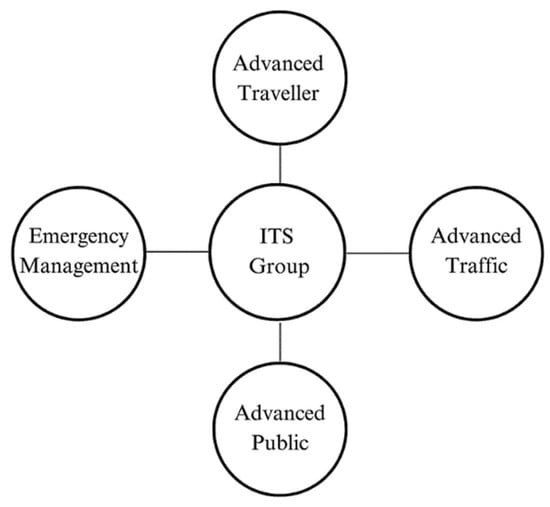
Figure 4.
ITS main groups [].
These real-world examples highlight the diverse applications and benefits of ITS in improving traffic management, enhancing public transit services, and promoting sustainable urban mobility in different cities and regions worldwide. Singapore is renowned for its innovative approach to urban mobility. The city-state has implemented various ITS technologies to manage traffic congestion and enhance transportation efficiency. For example, Singapore’s Electronic Road Pricing (ERP) system uses gantry-mounted sensors and smart tolling to adjust road usage fees based on real-time traffic conditions. The Land Transport Authority (LTA) has also deployed traffic monitoring cameras, adaptive traffic signal control systems, and real-time traveler information services to improve traffic flow and reduce roadway congestion.
London implemented a congestion pricing scheme in 2003 to alleviate traffic congestion in the city center. The congestion charge applies a fee to vehicles entering designated zones during peak hours, encouraging motorists to use alternative modes of transportation or travel outside peak times. The scheme has successfully reduced traffic congestion, improved air quality, and generated revenue for investment in public transportation infrastructure [].
Stockholm implemented a congestion pricing system in 2006 to reduce traffic congestion and improve air quality in the city center. The congestion charge uses automatic license plate recognition technology and electronic tolling to charge vehicles entering the congestion zone during peak hours. The scheme has effectively reduced traffic congestion, increased public transit ridership, and promoted sustainable urban mobility [].
Tokyo has implemented various ITS solutions to manage its complex transportation network and address urban mobility challenges. For example, Tokyo’s extensive network of intelligent traffic management systems uses advanced technologies such as adaptive traffic signal control, surveillance cameras, and real-time traffic information to optimize traffic flow and reduce congestion on major roadways. Tokyo’s public transportation system, including its extensive rail network and integrated fare payment systems, also provides efficient and reliable mobility options for residents and visitors [].
2.2. Intelligent Transportation Communication Technologies
ITS communication technologies allow all systems to work in an integrated manner. The Road Side Unit (RSU) systems located on the roadside can not transfer the information they receive from the vehicle to the center. In particular, vehicle navigation systems receive vehicle location information on maps and transmit it to the center thanks to GPS. ITS communications are made from vehicle-to-vehicle (V2V), vehicle-to-infrastructure (V2I), and vehicle-to-anywhere (V2X). Also, quantum technology is poised to play a significant role in developing next-generation 6G wireless communications. Quantum technology can help achieve ultra-secure communication, enhanced data rates, massive parallel computation, and enhanced localization and navigation capabilities in next-generation 6G wireless networks. Using such systems as safe communication in ITS applications is possible to make systems safer []. ITS communication systems are shown each serves equipment’s between others in Figure 5.
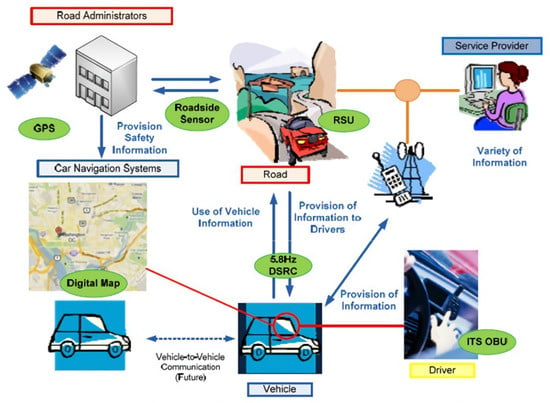
Figure 5.
ITS communication systems [].
2.2.1. Global Navigation Satellite System
The Global Navigation Satellite System (GNSS) is preferred in the field of ITS to access location information in travel planning, routing applications, vehicle tracking systems, and similar applications [].
2.2.2. Detection Technologies
Detection technologies are sensor-based systems for measuring road, environmental, air, and vehicle information that ITS needs. In this field, vehicle counting is used to provide data on traffic density, road, air, and emission status. In particular, thanks to the processing and use of data obtained from mobile devices on which they have travel planning software installed, as well as data from sensors located on the roadside, drivers can make alternative route suggestions on the route [].
2.2.3. Dedicated Short-Range Communications
Dedicated Short-Range Communications (DSRC) is a wireless communication technology designed specifically for vehicle-to-anywhere (V2X) communication. It is a technology used in fee collection applications. It is one of the best examples that can be given about collecting fees with the Automatic Pass System (APS), which has been used in our country since 1999. In future ITS studies, vehicle-to-vehicle (V2V) will play an important role in vehicle-to-infrastructure (V2I) communication []. The data collection systems are shown in Figure 6.
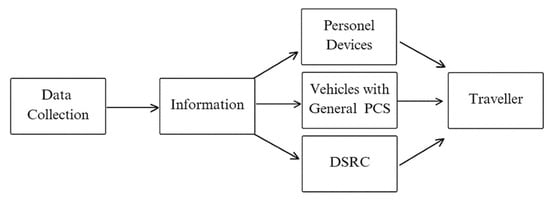
Figure 6.
Data collection systems.
2.2.4. Radio Frequency Identification
Radio Frequency Identification (RFID) systems are used in toll collection systems in places such as bridges and highways during the passage of vehicles. These structures, which have standards, can be used in the field of ITS as both active and passive systems [].
2.2.5. Low-Power Wide-Area Network
Technologies, distributed over a wide range of areas, offer wireless communication for low-power machine-to-machine (M2M) and IoT devices. Some of the Low-Power Wide-Area Network (LPWAN) technologies are NarrowBand IoT, Long Range (LoRa), and Sigfox. It uses the Global System for Mobile (GSM) network. In this technology, sensors and cameras are used. All end devices can collect their data in a central place with different communication technologies [].
2.2.6. Cooperative Intelligent Transportation Systems
Cooperative Intelligent Transportation Systems (C-ITS) are used in systems that are important in terms of ITS applications and in terms of efficiency, safety, and environmental friendliness in transportation. It is also one of the innovative technologies aimed at improving these systems, allowing tools and applications to interact directly with each other. According to C-ITS, communication devices placed inside the vehicle and on the roadside will provide vehicle-to-vehicle and vehicle-to-infrastructure communication, informing drivers about all events occurring on the road and ensuring safe and comfortable travel []. The interoperability of C-ITS communication systems and all transportation systems is shown in Figure 7.
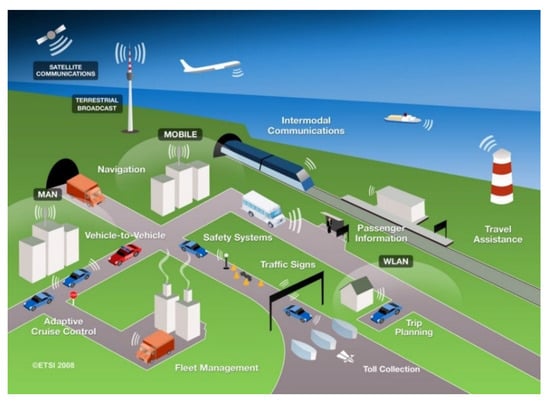
Figure 7.
Cooperative Intelligent Transportation Systems (C-ITS) [].
2.2.7. Cellular Communication Networks
ITS, 3G, 4G, 4.5G, 5G, and future communication technologies are used for communication purposes such as mobile communication technologies, security, navigation, in-vehicle information systems, and entertainment services [].
2.2.8. Near-Field Communication
Near-Field Communication (NFC) technology is a new generation near-field wireless communication technology on 8 December 2003, to be used for payment and communication purposes in ITS applications developed by ISO/IEC. Usage areas of NFC technology in ITS, information sharing, data exchange, public transportation, payment, etc. In recent years, making payments with contactless cards and paying for tickets with mobile phones and smartwatches in public transport are some good examples of NFC technology [].
2.3. Intelligent Transportation System Architecture
ITS architecture is the blueprint for designing, implementing, and operating a cohesive and efficient transportation system that leverages advanced technologies to enhance safety, mobility, and sustainability. The ITS architecture consists of four main layers. These layers are the perceptive, network transmission, database, and application layers. At the network layer, the communication method of the relevant system is determined. The related servers, storage architecture, and data are collected and backed up in the database layer. In the application layer, which system and which points will be managed is determined. The perceptive layer has equipment such as a camera, speed sensor, and signal lamps.
ITS architecture is the blueprint for creating a cohesive and efficient transportation network. By integrating various advanced technologies and subsystems, ITS architecture aims to enhance safety, improve mobility, and promote sustainability in transportation systems. It provides the framework for designing, implementing, and operating a robust infrastructure that effectively manages traffic flow, optimizes resource utilization, and responds to dynamic transportation challenges. In essence, ITS architecture is instrumental in shaping the future of transportation, enabling smarter, safer, and more sustainable mobility solutions.
In an architecture created for planning, user services that are expected to be performed by ITS applications, the assets in which these services will be located, and the data and information flow between these assets and the services should be defined. In a simpler form, it describes what it does, where it works, and what information is transferred between its components. User services refer to the activities provided by ITS and constitute services such as providing travel information, managing traffic, collecting fares electronically, tracking traffic accidents, and tracking commercial fleets. ITS physical architecture is shown in detail in Figure 8.
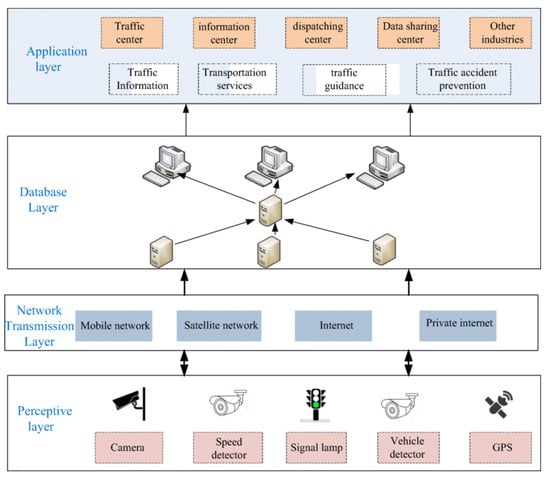
Figure 8.
ITS physical architecture [].
Assets are users or system administrators who interact with physical places where user services are provided, such as a traffic management center and public transport. An example of this is GPS. The important point here is its compatibility with information and communication technologies. Suppose software or hardware components in the system are changed. In that case, the system should be able to continue to function, and interfaces and functional features between components should be clearly and consistently defined in the system architecture. Many developed countries worldwide have started studies to create ITS architecture, and it is seen that the architectures created by developed countries such as the United States, European Union countries, Japan, and South Korea, especially in the 1990s, are also taken as examples by other countries. The RSU collects traffic data from a static sensing area along a road and transmits data to traffic control devices and a central traffic management center. These devices also serve as an information source for intelligent vehicles to collect future traffic information []. ITS examples with GPS systems are given below in Figure 9.
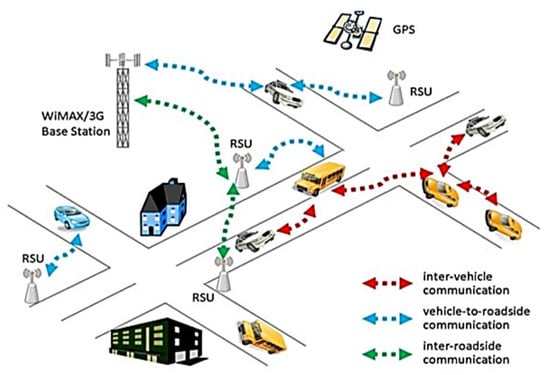
Figure 9.
ITS example with GPS [].
2.4. Intelligent Transportation System Infrastructure
ITS is considered as all systems as infrastructure. Intelligent transportation infrastructure systems communicate with each other continuously, and data are collected in a single center, facilitating management. Intelligent vehicle systems include collision avoidance, user assistance, and collision warning systems. When looking at infrastructure systems, all systems are systems that must be implemented for the system to be smart. Physical infrastructure has two systems intelligence infrastructure and intelligence vehicles. All sub-infrastructure including other systems are shown in Figure 10.

Figure 10.
Physical infrastructure [].
2.5. Intelligent Transportation Systems Advantages
ITS, especially in smart cities, integrates systems, bringing many conveniences. These conveniences add comfort features to the life of society. In addition, the advantages provided are spreading to all smart city systems. The benefits of ITS applications, which have become widespread with the developing technology, are detailed below.
- Low CO2 mission,
- Reduced traffic accident,
- Improving the quality of life of people,
- Use of roads following the capacity,
- Reduced transportation time,
- Creation of infrastructure for increasing mobility,
- Reduced traffic jams,
- Elimination of infrastructure problems,
- Development of environmentally friendly systems,
- Increasing the orientation to public transport,
- Improving driver safety and accident management,
- Determination of traffic density,
- Data integration of density,
- Data integration between different systems,
- Superiority in transit, and
- Ensuring improved traffic flow and safety.
3. The Impact of Innovative Technologies on Intelligence Transportation Systems
3.1. Internet of Things
IoT introduces the networking of physical objects through the use of embedded sensors, actuators, and other devices that can collect and transmit information about real-time action on the network. IoT sensors are well suited to a dynamic part of the haul truck industry, allowing for team-building capability where trucks are driven in combination. It is intended to increase the capacity of roads through an automated highway system. It reduces the distance between electronics and cars or trucks [].
3.2. Cloud Computing
Cloud computing is a general term for information services that provide computing resources that are shared among users and are always available to computers and other devices on the internet. Cloud computing is predicted to transform the automotive industry, transportation, and services. The development of cloud computing technologies and the IoT will help solve traffic problems such as congestion and vehicle safety. In recent years, researchers have proposed cloud models such as ITS-cloud for ITS to improve vehicle-to-vehicle communication and road safety [].
3.3. Big Data
Big data, unlike traditional data, is an extensive dataset that must be collected and analyzed using new technologies and algorithms. In other words, it is about collecting, storing, cleaning, visualizing, analyzing, and interpreting large amounts of diverse and fast-moving data from sensors and scientific instruments. The big data platform has five components: diversity, speed, volume, validation, and value. Big data, with its high data production rate and high data variability, makes it possible to understand data and optimize processes and high volumes of information [].
3.4. Artificial Intelligence and Machine Learning
Developed countries’ studies are being carried out to provide safer, more efficient, and sustainable transportation services for the use of artificial intelligence in predicting the behavior of the transportation system, solving transportation problems, in the transportation planning process, and in the most appropriate way. As a result of studies on autonomous vehicles, connected vehicles, and smart road systems, there is a transformation in the transportation sector. Rapid advances are made in the driverless vehicle industry with applications such as machine learning, deep learning technologies, big data, real-time detection, traffic forecasting, and smart decision-making. Thanks to all of these technologies and the pre-analysis of traffic scenarios, it is predicted that accident situations can be detected early and accidents can be avoided [].
3.5. Blockchain Technologies
Blockchain technology can create up-to-date, real-time, and consistent transactions without a central authority. It will ensure that irrefutably secure vehicle and driver records are created throughout the vehicle usage lifecycle. A healthy and secure vehicle information system will be created by solving data integrity and reconciliation-related problems. At the same time, the Blockchain-based vehicle information management system, which will work by integrating with smart tool kits, will obtain real-time and reliable data. It will provide an efficient, secure, and non-human intervention-free data management and communication platform to the stakeholders in the wide and integrated connected vehicle ecosystem who do not trust each other [].
3.6. Generation (5G) Mobile Networks
Generation (5G) mobile networks will form the mobile communication infrastructure of the future. It will have much higher capacity and less latency than existing 4.5G systems. The wireless broadband infrastructure that these networks will provide connectivity not only for smart transportation services but also for many IoT applications [].
3.7. Quantum Information Technologies in 6G Networks
Quantum information technologies are poised to revolutionize the landscape of telecommunications, particularly in the context of 6G networks. These are Quantum Key Distribution (QKD), Quantum-Secure Communication Protocols, Quantum-Secured Internet of Things (IoT), Quantum-Sensing for Network Optimization, Quantum Machine Learning for Network Intelligence, and Quantum-Secured Satellite Communication. Incorporating quantum information technologies into 6G networks holds immense potential for enhancing security, reliability, and performance, ushering in a new era of ultra-secure and efficient telecommunications infrastructure [].
4. Intelligent Transportation System Security Challenges and Measures
4.1. ITS Security Issues and Challenges
Security problems can be made possible by taking advanced security measures in these systems. All cyber attack vectors should be considered while taking security measures. In particular, the subjects that have experienced and may experience ITS are discussed in Table 1.

Table 1.
ITS security issues and challenges.
4.2. ITS Cyber Attack Methods
Cyber attacks are aimed at stopping, shutting down, or completely crashing the system. Cyber attacks can be made over wired and wireless connections. In this section, possible attacks are examined. Security problems that may occur on ITS are evaluated in terms of cyber security and shown in Figure 11.
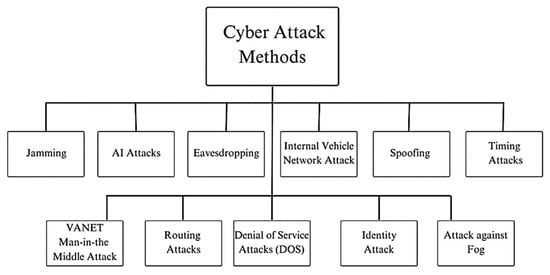
Figure 11.
ITS cyber attack methods [,,,,,].
The most important situation to protect ITS systems is to minimize and protect against cyber security attacks. The systems should not be turned off after the attacks. As a result of the attacks, financial losses, loss of reputation, information theft, and service interruption occur in the systems. Looking at the world in general, cyber attacks on ITS systems are increasing daily. When cyber attacks in ITS systems are examined, the most common attacks are VANET MiTM attacks, DDoS, and Internal Vehicle Network attacks [,].
4.3. Basic Security Requirements for ITS
ITS has become an important issue to consider in all communication systems regarding security. It is possible to implement security requirements that are common to all systems. The main goal is the complete security of interoperable systems and services in a sustainable working environment. All standards have been examined, and studies on this subject have been discussed. According to ETSI, one of the international security standards on which ITS systems are based, the minimum security requirements are below [,,,,,,,,,,,]. These requirements aim to protect systems against cyber attacks. The most important point is to protect the systems in the best way possible in case of an attack and to ensure that the necessary precautions are taken. The minimum precautions do not mean that the entire system will be protected one hundred percent. For this reason, experts and institutions should take necessary precautions by considering the requirements below.
In ITS applications, futuristic technologies such as AI, quantum calculation, blockchain, data science, deep learning, and generation security algorithms should be integrated, and security measures should be taken. They should also use the entire infrastructure to protect hybrid models safely [].
Basic security requirements for ITS [,,,,,,,,,,,]:
- No universal default passwords,
- Implement manage reports vulnerabilities,
- Keep software updated,
- Securely store sensitive security parameters,
- Communicate securely,
- Ensure software integrity,
- Ensure that personnel data are secure,
- Make it easy for users to delete user data,
- Validate input data,
- Maintenance of devices easy,
- Minimize exposed attack surfaces,
- Examine system telemetry data,
- Make systems resilient to outages,
- Using quantum security method, and
- Using a new generation of security algorithms.
5. Conclusions
Studies conducted in recent years show that with the increase in ITS awareness and its stakeholders’ tendency to act together, their work has accelerated. For this reason, ITS planning should be performed in a safe, economical, environmentally friendly, solution-oriented, and user-friendly manner, in line with ITS stakeholders’ views and relevant institutions’ objectives. With the development of technology in smart transportation systems, security attacks that pose great risks have begun to emerge. The danger of death in these unsafe areas greatly increases the severity of these attacks. These security issues must be considered for ITS systems to be efficient and sustainable. In particular, relevant institutions should invest more in this area, and safer ITS practices should be developed. ITS systems should be examined as a whole component in the future, and security maturity models of these systems should be developed. Studies on this subject should be supported. In addition, applications should be developed in this direction to integrate ITS systems with cloud computing, big data, quantum technologies, generative security algorithms, and IoT concepts to adapt to hybrid model-developing technology. The information in this study has been handled according to our area of expertise. The adequacy of the information given in terms of application will vary according to the application areas of the institutions. The success of these requirements and information in practice should be tested. In addition, in line with the information given, the aim should be to give the necessary results in the next studies by investigating whether the institutions and experts apply this information.
Author Contributions
Conceptualization, İ.A.; methodology, İ.A.; software, M.K.; validation, İ.A. and M.K.; resources, İ.A.; data curation, M.K.; writing—original draft preparation, M.K.; writing review and editing, İ.A.; supervision, İ.A. All authors have read and agreed to the published version of the manuscript.
Funding
The research received no external funding.
Institutional Review Board Statement
Not applicable.
Informed Consent Statement
Not applicable.
Data Availability Statement
Data is contained within the article.
Conflicts of Interest
The authors reported no potential conflicts of interest.
Nomenclature
| ITS | Intelligent Transportation Systems |
| GPS | Global Positioning System |
| ERTICO | European Road Transport Telematics Implementation Coordination |
| VANET | Vehicular Ad Hoc Network |
| ETSI | European Telecommunications Standards Institute |
| NEMA | National Electrical Manufacturers Association |
| ISO | International Organization for Standardization |
| CACS | Comprehensive Automobile Traffic Control Systems |
| ERGS | Electronic Route Guidance System |
| RSU | Road Side Unit |
| V2V | Vehicle-To-Vehicle |
| V2I | Vehicle-To-Infrastructure |
| V2X | Vehicle-To-Anywhere |
| GNSS | Global Navigation Satellite System |
| DSRC | Dedicated Short-Range Communications |
| APS | Automatic Pass System |
| RFID | Radio Frequency Identification |
| M2M | Machine-To-Machine |
| LPWAN | Low-Power Wide-Area Network |
| LoRa | Long Range |
| C-ITS | Collaborative Intelligent Transportation Systems |
| NFC | Near-Field Communication |
| WAWC | Wide Area Wireless Communication |
| WC | Wireless Communication |
| MIRT | Mobile With Mobile Infrared Transmitters |
References
- Katanalp, B.Y.; Yıldırım, Z.B.; Eren, E.; Uz, V.E. An Evaluation on Intelligent Transportation Systems. In Proceedings of the Second International Symposium on Innovative Approaches in Scientific Studies, Samsun, Turkey, 30 November–2 December 2018. [Google Scholar]
- Sakiz, F.; Sen, S. A survey of attacks and detection mechanisms on intelligent transportation systems: VANETs and IoV. Ad Hoc Netw. 2017, 61, 33–50. [Google Scholar] [CrossRef]
- Özarpa, C.; Avcı, İ.; Kınacı, B.F. Critical Level Analysis of Subsystems Used in Smart Rail Systems. J. Railw. Eng. 2021, 14, 143–153. [Google Scholar] [CrossRef]
- Rafat, M.; Azadi, S. A Novel Flexible Lane Changing (FLC) Method in Complicated Dynamic Environment for Automated Vehicles. J. Appl. Comput. Mech. 2021, 9, 318–331. [Google Scholar] [CrossRef]
- Lamssaggad, A.; Benamar, N.; Hafid, A.S.; Msahli, M. A Survey on the Current Security Landscape of Intelligent Transportation Systems. IEEE Access 2021, 9, 9180–9208. [Google Scholar] [CrossRef]
- Lu, Z.; Qu, G.; Liu, Z. A Survey on Recent Advances in Vehicular Network Security, Trust, and Privacy. IEEE Trans. Intell. Transp. Syst. 2019, 20, 760–776. [Google Scholar] [CrossRef]
- ISO/IEC 27001:2022; Information Security, Cybersecurity and Privacy Protection-Information Security Management Systems. ISO: Geneva, Switzerland, 2022.
- NIST Cybersecurity Framework (CSF) 2.0.; IST Cybersecurity Framework; NIST: Gaithersburg, MD, USA, 2024.
- GDPR. General Data Protection Regulation; European Union: Brussels, Belgium, 2016. [Google Scholar]
- ETSI (European Telecommunications Standards Institute). European Union, Brussels, Belgium. 1988. Available online: https://www.etsi.org/ (accessed on 22 January 2023).
- NEMA (National Electrical Manufacturers Association). Washington, DC, USA. 1926. Available online: https://www.nema.org/ (accessed on 22 January 2023).
- Javed, M.A.; Ben Hamida, E.; Al-Fuqaha, A.; Bhargava, B. Adaptive Security for Intelligent Transport System Applications. IEEE Intell. Transp. Syst. Mag. 2018, 10, 110–120, hal-01591878. [Google Scholar] [CrossRef]
- Kiela, K.; Barzdenas, V.; Jurgo, M.; Macaitis, V.; Rafanavicius, J.; Vasjanov, A.; Kladovscikov, L.; Navickas, R. Review of V2X–IoT standards and frameworks for ITS applications. Appl. Sci. 2020, 10, 4314. [Google Scholar] [CrossRef]
- Meena, G.S.; Sharma, D.; Mahrishi, M. Traffic Prediction for Intelligent Transportation System using Machine Learning. In Proceedings of the 3rd International Conference on Emerging Technologies in Computer Engineering: Machine Learning and Internet of Things (ICETCE), Jaipur, India, 7–8 February 2020; pp. 145–148. [Google Scholar] [CrossRef]
- Hamida, E.B.; Noura, H.; Znaidi, W. Security of Cooperative Intelligent Transport Systems: Standards, Threats Analysis and Cryptographic Countermeasures. Electronics 2015, 4, 380–423. [Google Scholar] [CrossRef]
- ETSI. Available online: https://www.etsi.org/deliver/etsi_en/303600_303699/303645 (accessed on 22 January 2023).
- Eliasson, J.; Hultkrantz, L.; Nerhagen, L.; Rosqvist, L.S. The Stockholm congestion–charging trial 2006: Overview of effects. Transp. Res. Part A Policy Pract. 2009, 43, 240–250. [Google Scholar] [CrossRef]
- Balaban, O.; Puppim de Oliveira, J.A. Finding sustainable mobility solutions for shrinking cities: The case of Toyama and Kanazawa. J. Place Manag. Dev. 2022, 15, 20–39. [Google Scholar] [CrossRef]
- Rozenman, G.G.; Kundu, N.K.; Liu, R.; Zhang, L.; Maslennikov, A.; Reches, Y.; Youm, H.Y. The quantum internet: A synergy of quantum information technologies and 6G networks. IET Quantum Commun. 2023, 4, 147–166. [Google Scholar] [CrossRef]
- Macioszek, E. Architecture of intelligent transportation systems in the world and in Poland. Arch. Transp. Syst. Telemat. 2014, 7, 22–26. [Google Scholar]
- An, S.; Lee, B.-H.; Shin, D.-R. A Survey of Intelligent Transportation Systems. In Proceedings of the 2011 Third International Conference on Computational Intelligence, Communication Systems and Networks, Bali, Indonesia, 26–28 July 2011; pp. 332–337. [Google Scholar] [CrossRef]
- Dovis, F.; Ruotsalainen, L.; Toledo-Moreo, R.; Kassas, Z.Z.M.; Gikas, V. Recent advancement on the use of global navigation satellite system-based positioning for intelligent transport systems [guest editorial]. IEEE Intell. Transp. Syst. Mag. 2020, 12, 6–9. [Google Scholar] [CrossRef]
- Bangui, H.; Buhnova, B. Recent advances in machine-learning driven intrusion detection in transportation: Survey. Procedia Comput. Sci. 2021, 184, 877–886. [Google Scholar] [CrossRef]
- Cheek, E.; Alghodhaifi, H.; Adam, C.; Andres, R.; Lakshmanan, S. Dedicated short range communications used as fail-safe in autonomous navigation. Unmanned Syst. Technol. XXII 2020, 11425, 159–177. [Google Scholar]
- Choy, J.L.C.; Wu, J.; Long, C.; Lin, Y.-B. Ubiquitous and low power vehicles speed monitoring for intelligent transport systems. IEEE Sens. J. 2020, 20, 5656–5665. [Google Scholar] [CrossRef]
- Gu, F.; Niu, J.; Jiang, L.; Liu, X.; Atiquzzaman, M. Survey of the low power wide area network technologies. J. Netw. Comput. Appl. 2020, 149, 102459. [Google Scholar] [CrossRef]
- Vintageroadhaulage. Available online: http://www.vintageroadhaulage.com.au/faq/c-its/ (accessed on 11 January 2023).
- Zhang, H.; Lu, X. Vehicle communication network in intelligent transportation system based on Internet of Things. Comput. Commun. 2020, 160, 799–806. [Google Scholar] [CrossRef]
- Liébana-Cabanillas, F.; Molinillo, S.; Ruiz-Montañez, M. To use or not to use, that is the question: Analysis of the determining factors for using NFC mobile payment systems in public transportation. Technol. Forecast. Soc. Chang. 2019, 139, 266–276. [Google Scholar] [CrossRef]
- Zhu, J.; Xu, W.; Sun, H.; Zhu, H. Research on optimization of shared bicycle real-time multimedia interactive dispatching system for intelligent transportation system. Multimed. Tools Appl. 2019, 82, 22299. [Google Scholar] [CrossRef]
- Vanni, P.R.M.; Jaimes, L.M.S.; Mapp, G.; Moreira, E. Ontology-driven reputation model for VANET. In Proceedings of the Twelfth Advanced International Conference on Telecommunications (AICT 2016), Valencia, Spain, 22–26 May 2016; IARIA: Barcelona, Spain, 2016; pp. 14–19. [Google Scholar]
- Cmu. Available online: https://www.cs.cmu.edu/~pb3a/presentations/aml_ferreira/sld006.html (accessed on 6 May 2023).
- Humayun, M.; Jhanjhi, N.; Hamid, B.; Ahmed, G. Emerging smart logistics and transportation using IoT and blockchain. IEEE Internet Things Mag. 2020, 3, 58–62. [Google Scholar] [CrossRef]
- Ferdowsi, A.; Challita, U.; Saad, W. Deep learning for reliable mobile edge analytics in intelligent transportation systems: An overview. IEEE Veh. Technol. Mag. 2019, 14, 62–70. [Google Scholar] [CrossRef]
- Çelik, U. Intelligent Transportation Systems and Big Data. In Proceedings of the 1st International Conference on Intelligent Transportation Systems (BANU-ITSC’18), Bandırma, Balıkesir, Turkey, 19–21 April 2018. [Google Scholar]
- Fatemidokht, H.; Rafsanjani, M.K.; Gupta, B.B.; Hsu, C.-H. Efficient and secure routing protocol based on artificial intelligence algorithms with UAV-assisted for vehicular ad hoc networks in intelligent transportation systems. IEEE Trans. Intell. Transp. Syst. 2021, 22, 4757–4769. [Google Scholar] [CrossRef]
- Mollah, M.B.; Zhao, J.; Niyato, D.; Guan, Y.L.; Yuen, C.; Sun, S.; Lam, K.-Y.; Koh, L.H. Blockchain for the Internet of Vehicles Towards Intelligent Transportation Systems: A Survey. IEEE Internet Things J. 2021, 8, 4157–4185. [Google Scholar] [CrossRef]
- Guevara, L.; Auat Cheein, F. The role of 5G technologies: Challenges in smart cities and intelligent transportation systems. Sustainability 2020, 12, 6469. [Google Scholar] [CrossRef]
- Akbar, M.A.; Khan, A.A.; Hyrynsalmi, S. Role of quantum computing in shaping the future of 6G technology. Inf. Softw. Technol. 2024, 170, 107454. [Google Scholar] [CrossRef]
- Hahn, D.M.; Munir, A.; Behzadan, V. Security and Privacy Issues in Intelligent Transportation Systems: Classification and Challenges. IEEE Intell. Transp. Syst. Mag. 2021, 13, 181–196. [Google Scholar] [CrossRef]
- Chavhan, S.G.; Gupta, D.; Garg, S.; Khanna, A.; Choi, B.J.; Hossain, M.S. Privacy and Security Management in Intelligent Transportation System. IEEE Access 2020, 8, 148677–148688. [Google Scholar] [CrossRef]
- Avcı, İ.; Özarpa, C.; Özdemir, M.; Kınacı, B.F.; Kara, S.A. Analysis of Multi-Layer Security System in terms of Cyber Attacks in Intelligent Transportation Vehicles. In Proceedings of the 2nd International Intelligent Transportation Systems Conference (BANU-ITSC’21), Bandırma, Turkey, 22–24 October 2021. [Google Scholar]
- Avcı, İ.; Koca, M. Predicting DDoS Attacks Using Machine Learning Algorithms in Building Management Systems. Electronics 2023, 12, 4142. [Google Scholar] [CrossRef]
- Harvey, J.; Kumar, S. A Survey of Intelligent Transportation Systems Security: Challenges and Solutions. In Proceedings of the 2020 IEEE 6th Intl Conference on Big Data Security on Cloud (BigDataSecurity), Baltimore, MD, USA, 25–27 May 2020; pp. 63–268. [Google Scholar]
- Zheng, K.; Zheng, Q.; Chatzimisios, P.; Xiang, W.; Zhou, Y. Heterogeneous Vehicular Networking: A Survey on Architecture, Challenges, and Solutions. IEEE Commun. Surv. Tutor. 2015, 17, 2377–2396. [Google Scholar] [CrossRef]
- Sándor, Z.; Monostori, Á. Traffic Analysis of Specific Motorways with Different Usage Characteristics in Hungary with the Method of Section Control. Acta Tech. Jaurinensis 2020, 13, 211–245. [Google Scholar] [CrossRef]
- Nagy, V.; Horváth, B. Effect of Self-driving Buses on Vehicle Scheduling. Adv. Intell. Syst. Comput. 2021, 1278, 21–29. [Google Scholar] [CrossRef] [PubMed]
- Avcı, İ.; Koca, M. Cybersecurity Attack Detection Model, Using Machine Learning Techniques. Acta Polytech. Hung. 2023, 20, 29–44. [Google Scholar] [CrossRef]
- Kaur, J.; Ramkumar, K.R. The recent trends in cyber security: A review. J. King Saud. Univ.-Comput. Inf. Sci. 2022, 34, 5766–5781. [Google Scholar] [CrossRef]
- Faruk, M.J.H.; Tahora, S.; Tasnim, M.; Shahriar, H.; Sakib, N. A review of quantum cybersecurity: Threats, risks and opportunities. In Proceedings of the 2022 1st International Conference on AI in Cybersecurity (ICAIC), Victoria, TX, USA, 24–26 May 2022; IEEE: Piscataway, NJ, USA, 2022. [Google Scholar]
Disclaimer/Publisher’s Note: The statements, opinions and data contained in all publications are solely those of the individual author(s) and contributor(s) and not of MDPI and/or the editor(s). MDPI and/or the editor(s) disclaim responsibility for any injury to people or property resulting from any ideas, methods, instructions or products referred to in the content. |
© 2024 by the authors. Licensee MDPI, Basel, Switzerland. This article is an open access article distributed under the terms and conditions of the Creative Commons Attribution (CC BY) license (https://creativecommons.org/licenses/by/4.0/).